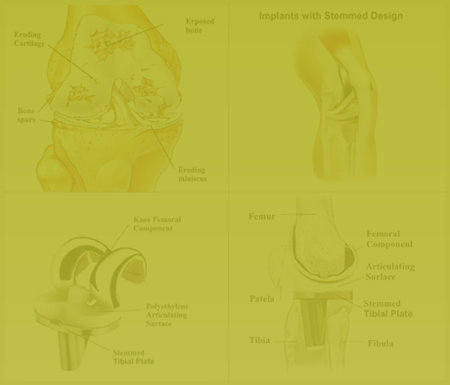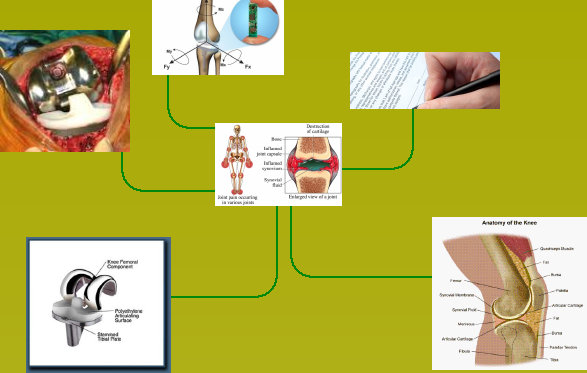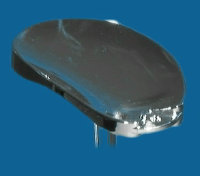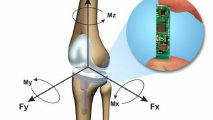
By Gelareh Eslamian

There are various forms of knee implant, which will be used for patients based on their problem, age, and amount of activity. Finding
the appropriate knee implant for each patient depends on the surgeonís decision.
1) Knee Interpositional Device:
This device allows the patients flexibility of movement and greater mobility which is otherwise not possible right after surgery. It is tailor made to fit to every size according to individualís requirements and body type. It closely looks like the human joint geometry and its elaborate design makes eliminates the use of screws and other types of devices used to keep the joint in place. Also it has a longer life since it is highly resistant to wear and tear resulted due to day to day activities (21).

Figure 4 : Knee Interpositional Device(21)
2 )Fixed Bearing Prosthesis:
This device is made up of a polyethylene cushion and helps in reducing severe pain to a great extent. In this case, the femoral part
is made from a strong metal that is placed on the lower segment of the thighbone. Moreover, high density polyethylene forms the tibial
component (the piece of prosthesis that locates on a metal tray) and the patellar part, which will replace the kneecap. The advantage
of this type of knee implant is its low cost. But it also has a disadvantage; extra weight and extreme activity easily results in
loosening the implant from the bone by increasing the wear on various parts of prosthesis (23).
3) Rotating Platform Flex Knee Replacement:
It is also an advanced innovation in the field of knee implant and comes as a blessing to the orthopedic patients worldwide. This
device allows complete knee bending which is necessary for several regular activities and which was otherwise previously forbidden
for patients undergoing knee joint surgery. The Rotating Knee Replacement of the RPF (Rotating Platform Flexion) is designed to give
better flexibility to the knee joint. In contrast to the fixed bearing conventional knee where the knee movement is restricted to
100 degrees, considered inadequate by some patients, this new device claims flexibility to as much as 155 degrees (9).Therefore it
is especially suitable to people with hyper activity such as young patients, and patients with weight problems (obese or over weight
patients) who exert greater force on the knee joint as compared to other regular patients.
For people who their daily movement and
functions require a very flexible knee implant, the best option is ďRotating Platform FlexĒ also known as RPF. In this design, the
function of posterior cruciate ligament is replaced by post of tibial plastic insert and cam of femoral component. Cruciate ligaments
are pairs of ligaments that make the joint stable while give it a large range of movement. This design has some other benefits as
well.This device guarantee s small amount of contact stress in deep flexion. Also, the improved post and cam mechanism will provide
a third weigh bearing surface. There is a bearing that moves between two parts of the joint, and because of this mobility, the most
possible contact area will stay in rotation. Moreover, predication of the rollback of the posterior, and improving the posterior curve
of the femoral condyle add to the flexibility of this knee implant. After complete recovery, patient can have a normal life style,
and activities such as cross-legged sitting that is impossible for most people with knee implant can be done. There is only one point
that should be considered during implanting RPF. Since the tibial bearing is mobile, and it rotates, it should keep stable in its
position. To do so, there should be a perfect balance between soft tissue and ligament. Also, it has resistance to wear or tear, so
it will perform properly for a longer time.The comparision of "fixed bearing" and "mobile bearing" is listed below(table2):

4)Medial Pivotal:
This device is an exact replica of our natural knee as it has the capability to perform all those functions that are performed by
a natural knee joint, such as walking, running, climbing stairs, and bending, which is not the case in other regular types of implants.In
that sense this device promises greater flexibility in terms of movements which are otherwise either restricted or forbidden post
surgery (21).

Figure 5 : Medial Pivotal (21)
There are a couple of companies that have made different medial pivots. One of the most recent medial pivot is called ADVANCE Medial-
Pivot Knee manufactured by Wright. This device is very stable during regular knee movement, while other knee implants will slide forward
a little. The old idea about knee implantís function was something similar to door hinge, which only moves back and forth. But thatís
not true, since the knee needs to rotate and bend.A healthy knee rotates on its inner side (medial)condyle. When the knee bends, the
outer side rolls back while the medial part rotates in place. Since this new design works very similar to healthy knee, they have
called that ADVANCE Medial- Pivot Knee. Not only this device allow the patients to twist, bend, and rotate their knees, but it also
has some other advantages. It has good range of movement and stability. In this design, the contact area between polyethylene tibial
and femoral implant was maximized. Thus the applied force will be spread over a larger area compare to regular designs of knee implant.
As a result, this device has low wearing surface that causes lasting fora longer time (1) .

One of the great advantages of ADVANCE Medial- Pivot Knee is great range of motion. The curvature of the femoral section of this device
is constant, and the tibia supports the femur throughout the complete range of movement. Therefore, patientís weight will be spread
out uniformly when he/she straighten or bend the knee.

In addition, this device has been designed by specific instrumentations that allow it to be implanted minimally invasive. Smaller
incision (4-6 inches) is needed, which results in faster recovery period, and less pain (1).
5) Gender Specific Knee Implant:
One of the greatest improvements in the field of knee implants is probably the development of gender specific knee implants. It is
considered to be a breakthrough accomplishment as prior to it there were no specific implants available to suit the anatomy of the
female knee joint. Although women too are vulnerable to knee related diseases such as osteoarthritis and the likes, they were essentially
denied the optimum benefits derived from medical treatment which was otherwise available to men at large. This new development means
better medical care, and less hospital stays as opposed to longer stays which the female patients had to undergo as a result of non
availability of gender specific implants leading to further complications and possible exposure to risks (5).
6) E- Knee:

7) Computer Navigation Technique:
The most exciting innovation in the field of knee replacement is using computer navigation through the surgery. There are some infrared
sensors that precisely detect the patientís anatomy, and map the arthritic knee. By applying special software, the computer will determine
the position of knee in the space. In addition, this program determines any bone loss or deformities. Then surgeons will insert some
inputs, and the software will calculate the intended anatomy of the knee. Then surgeon should interpret the output.
This detection
helps the surgeon in finding the best and the most accurate location for placing the knee implant. This technology improves the surgery
precision, which results in better performance of knee implant. By computer navigation, smaller incision is required that results
in faster and easier recovery. Moreover, the bone cuts will be made very accurate. The alignment of the cuts will be performed very
faster and simpler.Balancing the ligaments after the surgery is one of the key factors in getting a better result from the surgery.
Usually, detecting this balance is completely based on the surgeonís feeling. Yet, with computer navigation technology, the ligament
balancing will be computed to the nearest millimeter. Therefore, this technology will eliminate the alignment ďoutliersĒ. Although
usingthis technology will increase the surgery time 10 or 15 minutes ,because of increasing the accuracy and precision, it worth.
(19).
This novel device is the result of 13-year research. Various researchers from different institutes and companies worked together to
develop E-knee. This device is very similar to regular knee implants. The top half of this device is regular femoral part and polyethylene
surface.The difference is in the lower component. The lower part is made from titanium. It has been customized to do electrical measurements
of the stress on the knee. There is four metal posts that divide the bottom and top plates. A transducer is placed in each post that
evaluate the strain change in the metal while the subject moves. The transducers are connected to a transmitter that sends the data
to a computer (receiver) outside the body. The system will be activated by a coil that is located around the subjectís knee. Most
of the researchers for this device were from Scripps Institute. Among the companies worked on this design are; Microstrain (Williston,
VT) for the electronics and NK Biotechnology (Minneapolis, MN) for the transducers (3) . The advantage of this device will be reclined
in the future since patients will receive better treatments based on the collected information. Without applying this device, surgeons
and scientists use mathematical models to estimate the force on the knee implant during various activations. Yet, after using this
novel device, it became obvious that applied mathematical models were over estimating the load on the knee. For example, by using
computer models, the calculated force on the knee during climbing the stairs is 5.4 times the patient's body weight while by using
E-knee this value will be 2.5 times body weight. By using E-knee, surgeons can detect the amount and location of the stress on the
knee after various activities. Up to now, E-Knee is an experimental data so it can not be implanted in patients. But the obtained
information form this device will be useful for improving the current designs of knee implants, and customizing the knee implants
for each specific patient. For instance, specific knee implant can be designed for skiers or overweight person (15) .
Table2(9) : The comparision of "fixed bearing" and "mobile bearing"
Figure (6) : Comparison of "Advance Knee" and "Competitive Knee" (1)
Figure (7) : "Advance Knee" range of Motion (1)
Figure (8) : E-Knee Transducer (15)







